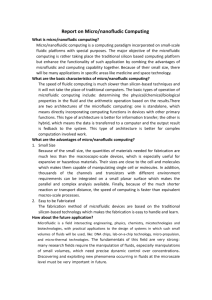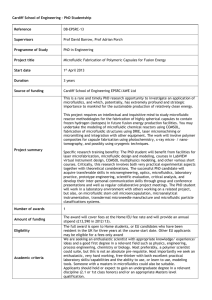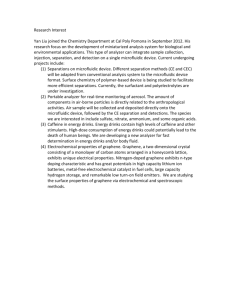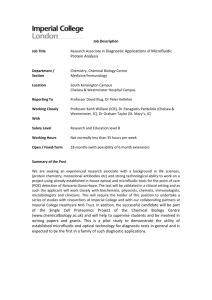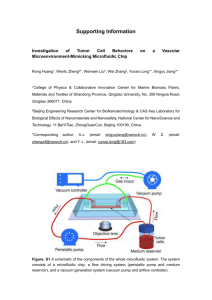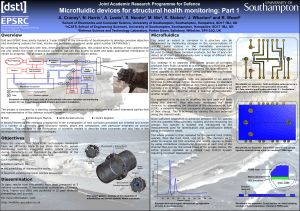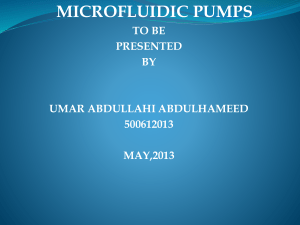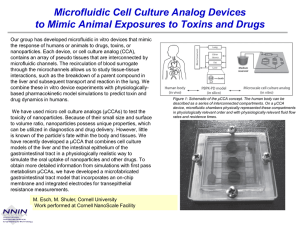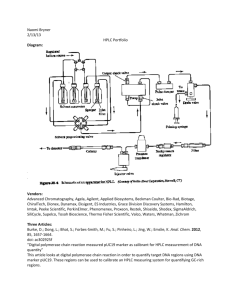4-electrophoresis-ms..
advertisement
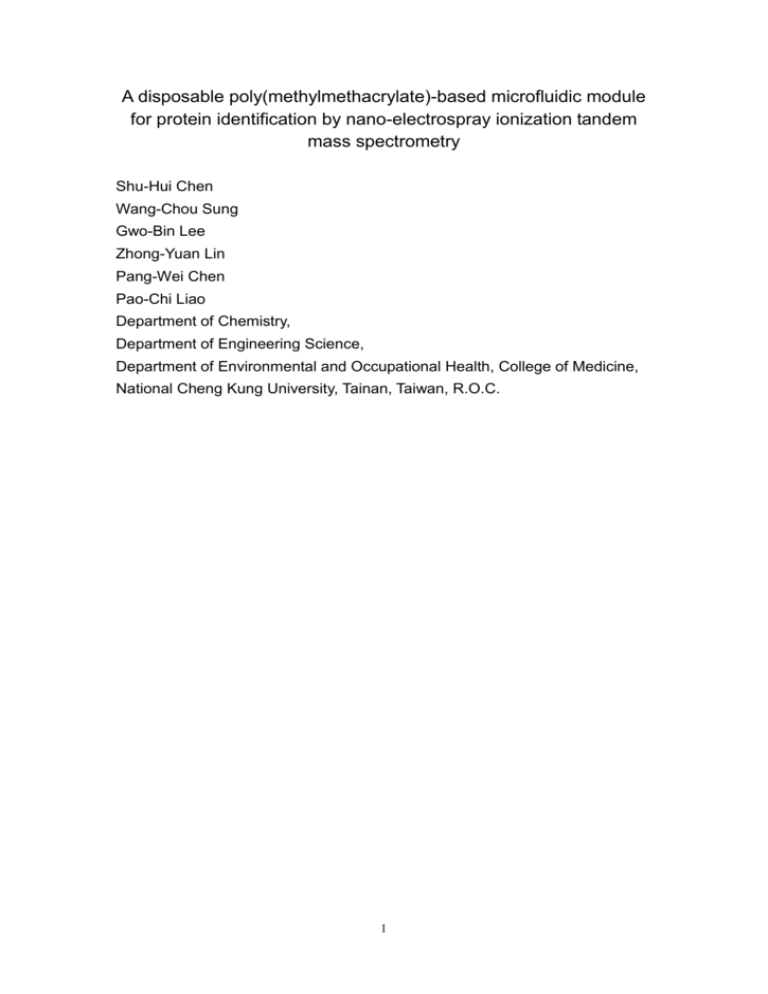
A disposable poly(methylmethacrylate)-based microfluidic module for protein identification by nano-electrospray ionization tandem mass spectrometry Shu-Hui Chen Wang-Chou Sung Gwo-Bin Lee Zhong-Yuan Lin Pang-Wei Chen Pao-Chi Liao Department of Chemistry, Department of Engineering Science, Department of Environmental and Occupational Health, College of Medicine, National Cheng Kung University, Tainan, Taiwan, R.O.C. 1 Abstract The design, fabrication, and its analytical utility of a poly(methylmethacrylate) (PMMA)-based microfluidic module for nano-electrospray tandem mass spectrometry (nano-ESI-MS/MS) were described. The microfluidic module can be mass-produced at low costs and used as a disposable device to generate nano-ESI-MS/MS signals for protein identification from low amount of protein samples. Compared with commercially available nanospray capillary tips, the module gave comparable signal quality and also offered advantages in convenience and easiness in operation, permitting repeated usages, and disposability. Keywords: poly(methylmethacrylate) (PMMA) / disposable microfluidic module / protein identification / proteomics / nano-electrospray ionization (nano-ESI) / tandem mass spectrometry 2 1 Introduction The advance of human genome project has shown many promises in biomedical research field. Within a few years, complete human genome sequence databases will be available to scientists for understanding disease mechanism, diagnosis, and new drug development [1]. While how the genomic sequence information will be exploited is still under intensive consideration, it is obvious now that, by using state-of-the-art mass spectrometry (MS) methods, proteins of interest to biomedical researchers can be mapped to sequence databases to find their identities [2]. This opens a possibility for systematic identification of the complete set of proteins that is expressed by the entire genome by a group of cells, that is, proteome. Proteome is a linguistic equivalent to the concept of genome. Proteomic research, or proteomics, refers to the studies of the proteome itself and the functional analysis of the proteins using technologies of large-scale protein identification [3-5]. To achieve large-scale protein identification, it has been speculated that microfabricated devices may provide an effective alternative solution to other means [6]. Microfabrication offers at least two major noticeable advantages, miniaturization and integration, and is therefore considered to be able to mass-produce microdevices at low costs to perform large-scale chemical analysis [7]. Microfabricated microfludic chips have been proposed to carry out chemical reaction, separation, and identification, and “lab-on-a-chip” is termed to describe such a microfludic system [6]. Recently, it is also noticed that microfludics for manipulating liquid solution is highly compatible with the 3 contemporary efforts to fabricate miniaturized electrospray (ESI), or nano-electrospray (nano-ESI), ion source to be used for MS [8]. A few dozens of papers have been published [9-30] and reviewed [6] to describe various microfludic devices in conjunction with ESI-MS or nano-ESI-MS systems. Most of the microfludic devices for ESI-MS reported to date used glass or quartz substrates [9-22]. The microfludic channels of the glass/quartz microdevices were typically fabricated by photolithographic, wet chemical etching, and cover bonding procedures [11]. There have been a few reports described the application of polymer materials, such as parylene [23], polycarbonate [24-26], poly(dimethylsiloxane) (PDMS) [27, 28], and poly(methylmethacrylate) (PMMA) [29, 30], to microfabricated ESI-MS devices. The microfabrication methods for the polymer substrates varied, ranging from simple knife cutting [30], replixa molding [27, 28], UV laser machining [24-26], X-ray lithography [29], to a complicated micromachining process on a silicon/parylene composite substrate [23]. In this report, we describe a PMMA-based microfluidic module fabricated by hot-embossing process using a quartz master template. The microfluidic module can be mass-produced at low costs and used as a disposable device to generate nano-ESI-MS signals for protein identification from low amount of protein samples. 4 2 Material and methods 2.1 Chemicals and Materials Methanol (HPLC grade) was purchased from Mallinckrodt (Phillipsburg, NJ, USA). Formic acid was purchased from Riedel-de Haeh (Seelze, Germany). Bovine serum albumin (BSA), fibrinopeptide A (M.W. 1536.6 Da), osteocalcin fragment 7-19 (M.W. 1407.6 Da), bradykinin (M.W. 1060.2 Da), LMYPTYLK (M.W. 1028.3 Da), and VGGYGYGAK (M.W. 871.0 Da) were purchased from Sigma Chemical Company (St. Louis, MO, USA). All reagents were of the highest grade available and were used directly without further purification. CE water was deionized distilled water that was filtered through a Barnstead E-pure system. The resistance of the water was more than 18.0 M/cm3. Both the buffer and sample solutions were filtered through 0.22 m membrane before chip electrophoresis. NanoES sparying capillaries (catalog# ES381) were purchased from Protana (Odense, Denmark). 2.2 Fabrication of nano-ESI microfluidic module The configuration of the microfabricated device (Figure 1) includes a cross microchannel and a fused silica tubing with a silver glue-coated nano-ESI tip. The cross microchannel was fabricated using hot embossing method [31, 32] on PMMA plexiglas substrate approximately 2 cm in width x 4 cm in length and 1.5 mm thick. Briefly, The micro channels on master templates were formed by the combination of metal etch mask and wet chemical etching. A commercial blank photo mask substrate (Nanofilm, Inc.) consisting of three layers (1 m 5 photoresist, 1 m Cr, and 2.3 mm quartz, respectively) was used as a master template on which micro capillary channels were fabricated. Image on the film is first transferred on photoresist (PR) by standard lithography using transparent film as a mask. After PR is developed, the blank photomask is immersed in Cr etchant to transfer patterns on Cr layer. Last, residual PR is stripped, revealing the transferred image on Cr layer, which will be used as etch mask for further quartz etching. Microfluidic channels on the quartz substrate were formed by the combination of metal mask (Cr) and buffered oxide etchant (BOE, 6:1) at room temperature to fabricate capillary channels with a smoother appearance. Quartz was etched in all areas surrounding the channels, and the resulting structure was inverse raised three-dimensional image of the channels. The microchannels were imprinted by pressing a quartz master template onto the top of a PMMA blank substrate. The entire device was heated at 103C for 5 minutes. Once the microchannels were formed, a Ni wire (400 m i.d.) was placed in the end of the separation channel to imprint a fitting channel for capillary tubing (Polymicro, 365 m o.d. and 50 m i.d.) at the same imprinting temperature. The resulting PMMA plate with microfluidic channels and the capillary tubing was then clamped with another PMMA cover plate to form the sealed channels with the attached capillary tubuing. The PMMA devices were heated at higher temperatures for at least 8 minutes for bonding. Prior to bonding, four through holes (1 mm in diameter) were drilled on the cover plate as analyte and sample reservoirs. The bonding strength of the chips was estimated to be about 1.0 MPa using homemade tensile test equipment. The UV glue was applied to fill the dead volume between the 6 microchip and the fused silica tubing. The tapered nano-ESI tip was formed by pulling the capillary against gravity with a weight of 33 grams. The resulting tip was about 80 m o.d. and 18 m i.d. Once the tip was formed, silver conductive glue (Electrolube Limited, Wargrave Berkshire, England) was painted on the surface of the tip by immersing the tip into glue with applying a gas stream or suction vacuum through the capillary. 2.3 Sample preparation, injection, and electroosmotic pumping Protein and peptide standards were dissolved in 50% methanol and 0.1% formic acid before analysis. One power supplier (CZE 1000R, Spellman, Hauppauge, NY, USA) was utilized to furnish the loading and electroosmotic voltages, and the power switching was done manually when the injection was needed. For continuous infusion mode, 6 kV was applied to the sample reservoir I. For injection mode, the sample loading was performed by applying 6 kV to the sample reservoir I for 0.2 minute, then switch manually the 6 kV to the reservoir II for electroosmotic pumping. The buffer solution was composed of 50 % methanol and 1% formic acid. 2.4 nano-ESI-MS/MS All the data were acquired using an API 365 triple quadrupole mass spectrometer (PE Sciex, Thornill, Canada) equipped with a home-built source housing to host nano-ESI microfluidic modules. For comparison purpose, some data were obtained using a commercially available nanospray capillary 7 tip from Protana. A mini camera (model # AVC 556N/F36(B), Hung-Li-Sun Co., Taipei, Taiwan) was installed inside the source housing to monitor spraying and the position of microfluidic module. An x-y-z translational stage was used to move the module for positioning. Low energy collision-induced dissociation (CID) experiments were performed using nitrogen (CID gas valve was set to 3) as the collision gas with that an optimized collision energy of 35 eV was used. Other instrument parameters (such as orifice, ring, and quadrupole voltages) were optimized by automatic tuning function provided by the API 365. The step size was set to 0.25 u and dwell time was set to 1 ms. 3 Results and discussion 3.1 The polymer-based nano-ESI-MS microfluidic module Figure 1 shows a diagram for the polymer-based nano-ESI-MS microfluidic module and its utility in protein identification. The microfluidic channels were formed with PMMA substrate using hot embossing by quartz master and the channels were closed by thermal bonding a covering PMMA plate. A pulled fused silica coated with silver glue at tip was inserted to the exit end of the channel and fixed with UV glue. Peptide samples can be loaded onto the module through sample reservoir I, and electroosmotically pumped to the nano-ESI emitter to generate peptide ion signals. In our laboratory, we regularly used commercially available nanospray tips (from New Objective, Inc., Cambridge, MA, U.S.A. or Protana, Odense, 8 Denmark) to generate nano-ESI ions from trypsinized protein sample excised from an electrophoresis gel. These tips are usually made by glass, quartz, or fused silica. In a typical situation, a protein spot of interest was recognized from visualized protein patterns by contrasting the differences between case and control electrophoresis gels. The spot was excised, digested by trypsin, and desalted by a reversed phase solid phase extraction trap (ZipTip, Millipore, Boston, MA, U.S.A.) The resulting solution containing tryptic peptide fragments was sprayed into a tandem mass spectrometer using the commercial nanospray tips to yield product ion scan mass spectra. The MS/MS data were used to search sequence database to find out the identity of the protein of interest. The polymer-based nano-ESI-MS microfluidic module can be used in a similar manner. Followed is a comparison in signal quality between those generated by a commercial available nanospray tip and a microfluidic module fabricated in our laboratory. 3.2 Signal quality Figure 2A and 2B are full-scan mass spectra obtained for a 10 pmol/L bradykinin standard solution using a microfluidic module fabricated in house and a Protana nanospray tip, respectively. Both mass spectra have comparable noise levels with major peaks at the same m/z value, 531.1, corresponding to doubly-protonated bradykinin, [M+2H]++. The singly-charged ion ([M+H]+, m/z 1061.2) was barely shown in Figure 2A or 2B. The signal intensities of the two base peaks were about the same. Consequently, both devices gave comparable signal-to-noise ratios for analyzing the bradykinin 9 standard solution. The signal stability was also compared. In Figure 3, the total ion current and ion current at m/z 531 were plotted against time for both the Protana nanospray tip and the microfluidic module. Both devices were able to generate stable ion signals lasting for more than 20 mins. Figure 4 shows that five consecutive injections were performed manually and their signals were recorded. The signal intensity varied less than 20% among injections. The variation could be reduced if automatic injections were used. The module was able to generate signals from consecutive injections, indicating that it could be integrated with other microfluidic modules to perform multiple analyses sequentially. In Figure 5, a mixture containing four peptides was analyzed and the results are shown for the analyses done by a Protana nanospray tip and a microfluidic module. In Figure 5A, all four doubly-charged ion species ([M+2H]++) were observed with strong intensities. Four singly-protonated peptide ions ([M+H]+) were also observed with smaller intensities and acceptable signal-to-noise levels. The signals appeared in Figure 5A are comparable to, or a little better than for some peaks, those in Figure 5B. 3.3 Comparison with commercially available nanospray tips Compared with the commercial nanospray tips, the polymer-based microfluidic modules were used differently in the following ways, despite that they shared some common features such as providing an interface between electrophoresis and mass spectrometry and both consumed about 1~3 L of 10 sample solution for each analysis. First, pressurizing the sample solution by compressed air in the commercial tips was usually required to initiate a stable nano-ESI signal. Frequently, it was also necessary to “break” the fine tip to start the nano-ESI, which we found sometimes difficulty to generate reproducible results and required experienced users. The sample solution was also necessarily loaded into the capillary tip by centrifugation. In contrast, when the microfluidic module is used, analyte solution was transferred to sample reservoir I by a micro-pipetter and electroosmotically pumped to the nano-ESI emitter, eliminating the tedious procedures to centrifuge, to air-pressurize, or to break the fine tip. Second, the microfluidic module was found to be useful for multiple repeated usages, more than 100 times without noticeable cross-contamination. In contrast, the commercial nanospray tips can usually be used for one sample since the tip end was “broken” and failed to load another sample by centrifugation. 3.4 Protein identification by searching sequence database Figure 6 shows an MS/MS spectrum and the corresponding sequence tag generated from a SDS-PAGE-separated protein, BSA. The protein band was silver-stained, excised, and subject to trypsin digestion. The resulting mixture was desalted by ZipTip and analyzed by the microfludic module. Although the signals were not strong, they could be used to deduce a sequence tag and the sequence tag was used to search PIR protein sequence database using software provided by PE SCIEX. The corresponding sequence tag was (592.2)(I/L)EN(951.4) and it mapped to the correct protein sequence in the 11 database. 4 Concluding remarks A PMMA-based microfluidic module fabricated by hot-embossing process using a quartz master template and by attaching a silver-coated pulled fused silica nano-ESI emitter, was described in this report. The use of quartz master template and hot-embossing, and the emitter was attached by UV-glue, made it possible to mass-produce these microfluidic modules at low costs. The analytical utility of the microfluidic module was compared with a commercially available nanospray tip, it was concluded that they gave comparable signal quality but the microfluidic module provide certain advantages such as convenience and easiness in operation, and permitting repeated usages without serious cross-contamination. Because of its potential in cutting manufacturing cost in mass production, it can be used as a disposable device after certain times of analyses, or for trace analysis where analyte carry-overs could potentially become a problem. Both the inputs and the outputs of microfluidic modules are liquids, so integration is readily achieved by modular designs and fabrication. As a goal to make the microfluidic devices to be a useful tool in proteomic research, additional investigations are undergoing in our laboratory to expand the function of the microfluidic module, including (1) an on-chip trypsin reactor module, (2) a desalting module, and (3) a frontal immunoaffinity-based extraction module. 12 5 References [1] Jungblut, P. R., Zimny-Arndt, U.,Zeindl-Ebernart, E.,Stulik, J.,Koupilova, K.,Pleibner, K.-P., Otto, A.,Muller, E.-C., Sokolowska-Kohler, W., Graher, G., Stoffler, G., Electrophoresis 1999, 20, 2100-2110. [2] Lahm,H-W., Langen, H., Electrophoresis 2000, 21, 2105-2114. [3] Kahn, P., Science, 1995, 270, 369-371. [4] Shevchenko, A., Jensen, O. N., Podtelejnikov, A.V., Sagliocco, F., Wilm, M., Vorm, O., Mortensen, P., Shevchenko, A., Boucherie, H., Mann, M., Biochemistry 1996, 93, 14440-14445. [5] Blackstock, W. P., Weir, M. P., TIBTECH 1999, 17, 121-127. [6] Figey, D., Pinto, D., Electrophoresis 2001, 22, 208-216. [7] Chen, Y., Pepin A., Electrophresis 2001, 22, 187-207. [8] Henry, C., Analytical Chemistry News & Features 1997, 68, 359A-361A. [9] Ramsey, J. M., Ramsey, R. S., Anal. Chem. 1997, 68, 1174-1178. [10] Lazar, L. M., Ramsey, R. S., Sundberg, S., Ramsey, J. M., Anal. Chem. 1999, 71, 3627-3631. [11] Xue, Q., Foret, F., Dunayevskiy, Y. M., Zavaracky, P. M., Mcgruer, N. E., Karger, B. L., Anal. Chem. 1997, 69, 426-430 [12] Xue, Q., Dunayevskiy, Y. M., Foret, F., Karger, B. L., Rapid communication in mass spectrometry 1997, 11, 1253-1256. [13] Zhang, B., Liu, H., Karger, B. L., Foret, F., Anal. Chem. 1999, 71, 3258-3264. [14] Zhang, B.,Froet, F., Karger, B. L., Anal. Chem. 2000,72, 1015-1022. [15] Figey, D., Ning, Y., Aebersold, R., Anal. Chem. 1997, 69, 3153-3160. 13 [16] Figey, D., Aebersold, B., Anal. Chem. 1998, 70, 3721-3727. [17] Figey, D., Gygi, S. P., Mckinnon, G., Aebersold, R., Anal. Chem. 1998, 70, 3728-3724. [18] Figey, D., Lock, C., Taylor, L., Aebersold, R., Rapid communication in mass spectrometry 1998, 12, 1435-1444. [19] Li, J., Thibault, P., Bing, N. H., Skinner, C. D., Wang, C., Anal. Chem. 1999, 71, 3036-3045. [20] Bings, N. H., Wang, C., Skinner, C. D., Colyer, C. L., Thibault, P., Harrison, D. J., Anal. Chem. 1999, 71, 3292-3296. [21] Li, J., Wang, C., Kelly, J. F., Harrison, D. J., Thibault, P., Electrophresis 2000, 21, 198-210. [22] Pinto, D. M., Ning, Y., Figeys, D., Electrophresis 2000, 21, 181-190. [23] Licklider, L., Wang, X.-Q., Desai, A., Tai, Y.-U., Lee, T. D., Anal. Chem. 2000, 72, 367-375. [24] Xu, N., Lin, Y., Hofstadler, S. A., Matson, D., Charles, J. C., Smith, R. D., Anal. Chem. 1998, 70, 3553-3556. [25] Xiang, F.,Lin, Y., Jenny, Wen., Matson, D. W., Smith, R. D., Anal Chem 1999,71,1485-1490. [26] Wen, J., Lin, Y., Xiang, F., Matson, D. W., Udseth, H. R., Smith, R. D., Electrophoresis 2000, 21, 191-197. [27] Chan, J. H., Timperman, A. T., Qin, D., Aebersold, R., Anal. Chem. 1999, 71, 4437-4444. [28] Liu, H., Felten, C., Xue, Q., Zhang, B., Jedrzejewski, P., Karger, B. L., Foret, F., Anal. Chem. 2000, 72, 3303-3310. 14 [29] Meng,Z., Qi, S., Soper, S. A., Limbach, P. A., Anal. Chem. 2001, 73, 1286-1291. [30] Yuan, C.-H., Shiea, J., Anal. Chem. 2001, 73, 1080-1083. [31] Kameoka, J., Craighead, H. G., Zhang, H., Henion, J. Anal. Chem. 2001, ASAP article on the web. [32] Sung, W.-C., Lee, G.-B., Tzeng, C.-C., Chen, S.-H., Electrophresis 2001, 22, 1188-1193. 15 FIGURE LEGENDS Figure 1. A disposable polymer-based nano-ESI-MS microfluidic module and its utility in protein identification. Figure 2. Full-scan mass spectra obtained for a 10 pmol/L bradykinin standard solution using a microfluidic module fabricated in house (A) and a Protana nanospray tip (B). Figure 3. The total ion current (A and B) and ion current at m/z 531 ([M+2H] ++) (C and D) were plotted against time for both the Protana nanospray tip (A and C) and the micro fluidic module (B and D), when they are tested using a 10 pmol/L bradykinin standard solution. Figure 4. The ion current at m/z 531 ([M+2H]++) resulted from five consecutive injections of 3 L of 10 pmol/L bradykinin standard solution. Figure 5. Full-scan mass spectra obtained for a mixture containing four peptides. The concentration of each was 10 pmol/L. The results were shown for the analyses done by a Protana nanospray tip (A) and the microfluidic module (B). Figure 6. Product ion scan mass spectrum obtained by the microfluidic module from an in-gel digestion mixture of 1.5 pmol bovine serum albumin separated on a SDS-PAGE gel. 16 17 (A) 531.0 1061.0 (B) 531.0 18 (A) (B) (C) (D) 19 20 531.0 (A) 515.0 768.5 436.5 871.0 1537.0 1028.6 1408.0 (B) 21 951.4 Sequence tag: (595.2)(I/L)EN(951.4) 595.2 I/L N 708.6 E 22 837.4
